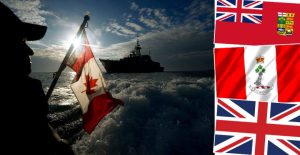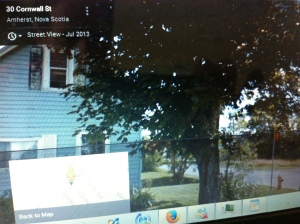I’ve long been fascinated by international borders and provincial boundaries. It started back in 1975-76. First, I decided in the Summer of 1975, between Grade 12 and 13 at Oshawa Catholic High School in Oshawa, Ontario, that I might was well catch a bus, head east, and then experience the end of the hitchhiking era. Part of that would involve borders. I recall walking across the Edmundston–Madawaska Bridge, an international bridge which opened in 1921 and connects the cities of Edmundston, New Brunswick, in Canada and Madawaska, Maine, in the United States, across the Saint John River. A new replacement bridge is currently under construction and scheduled to open in 2025.
I’m not sure quite what propelled me to walk over the river and into Aroostook County, Maine, but I think there was something about a girl in a bar in Madawaska (I know, sounds a bit like the opening salvo of a country-and-western song; I believe the legal drinking age may have been 18 in Maine at the time). I remember me back in Canada later sleeping in front of either Edmundston City Hall, or the Edmundston Police Force station (I’ve forgotten which, but the building was downtown, near the old S.M.T. (Eastern) Limited bus station, I think, in those days).
My next stop would be camping out with the same gear in Charlottetown in the back yard of the Government House of Prince Edward Island, often referred to as Fanningbank, where I was again neither disturbed or arrested, albeit I don’t recall then Lt.-Gov. Gordon Bennett inviting me in for some breakfast either.
The following year was the United States’ bicentennial. To mark the occasion in 1976, Canada’s official gift to the United States on its bicentennial was a coffee table-size book, Between Friends/Entre Amis, which was chalk full of exquisite border photographs, and introduced me to the International Boundary Commission. I gave the book to my parents for their anniversary that year.
Between Friends/Entre Amis was where I learned about places like the Haskell Free Library and Opera House, situated at 93 Caswell Avenue in Derby Line, Vermont and 1 Church Street in Stanstead Quebec. It straddles two nations, with one foot in the United States and the other in Canada. A black line running along the floor – a strip of masking tape – marks the international border, separating the towns Derby Line, Vermont, from Stanstead, Quebec. The front door, community bulletin board and children’s books are in the United States; the remainder of the collection and the reading room is in Canada.
In the Summer of 1979, I lived briefly in Blaine, Washington, directly across from 0 Avenue in the Douglas neighbourhood of Surrey, British Columbia. The houses on the north side of the street right were in Surrey, the houses on the south side were in Blaine. My neighbours across the street had British Columbia licence plates visible in their driveways, while neighbours on either side of me had had Washington plates in theirs.
In 1983, I remember tagging along on a trip or two to Akwesasne with Richard Russell, when he was the circulation manager of The Standard-Freeholder in Cornwall, Ontario, and I was a daily newspaper reporter there. This is also around the time I came to love Lancaster, Ontario perch rolls in hot dog buns.
Akwesasne is an incredibly complicated and complex place. Was then and is now.
I may even have enjoyed a pint or two back in the 1980s in the Halfway House, a tavern also known as Taillon’s International Hotel, where the barroom straddles the Canada-United States border between Dundee, Quebec and Fort Covington, New York, and that was built in 1820 before the international border in that area was surveyed. I remember the demarcation line drawn on the floor by the pool table, and admonitions not to transport alcoholic beverages from Quebec into New York and vice-a-versa.
Perhaps this borderland and interprovincial boundary fascination runs in the blood. I remember going to my birth mother’s place for the first time in August 1999. She lived near Amherst, Nova Scotia, on Fort Lawrence Road, east of Exit 1, where the Via Rail Ocean passenger train, with its haunting but not at all unwelcome whistle filling the air, en route from Montréal to Halifax, or Halifax to Montréal, crossing the saltwater Tantramar marshes between Amherst, Nova Scotia and Sackville, New Brunswick, a stone’s throw from the Missiguash River, bordering New Brunswick and Nova Scotia and connecting the Nova Scotia peninsula with those who come from away elsewhere in North America.
The saltwater Tantramar marshes, sometimes referred to singularly as the Tantramar Marsh, is a very special place indeed, and was even long before the first train crossed it in the 19th century. Memory surrounds you everywhere in Nova Scotia. This is the soil my Acadian ancestors lived and laboured on. This is Aulac Ridge, a prominent rise running west to east across the Tantramar marshes on the Isthmus of Chignecto, just west of the Missiguash River. This is the demarcation line between Fort Lawrence and Fort Beauséjour, New France and British North America, New Brunswick and Nova Scotia, overlooking the Cumberland Basin of the Bay of Fundy.
You can also follow me on Twitter at: https://twitter.com/jwbarker22








